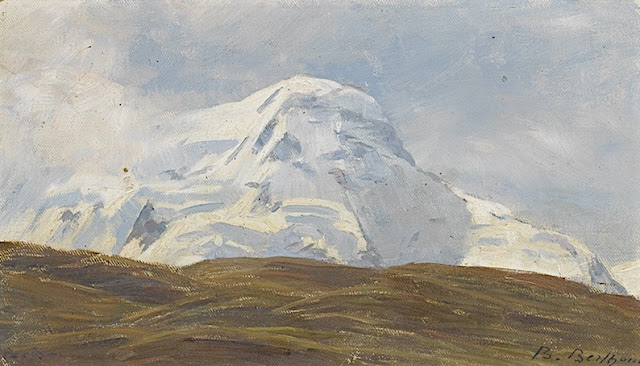
Mont Rose- Pointe Dufour (4,664 m)
Suisse - Italie
In Le mont Rose et le glacier du Gorner, Suisse, Autochrome Lumière, 1912,
La montagne
Le mont Rose (4 634 m), ou plus récemment massif du Mont-Rose - en titsch gressonard, Gletscher ou Glescher, littéralement « montagne glacée » ou « glacier » , en italien, Monte Rosa —, situé à la frontière entre la Suisse et l'Italie, est le deuxième plus haut massif des Alpes après celui du Mont-Blanc. Son point culminant, la pointe Dufour, à 4 634 m est le quatrième plus haut sommet des Alpes et le plus haut de Suisse. Au sommet de la Signalkuppe est situé le plus haut bâtiment et refuge d'Europe, la cabane Reine-Marguerite, à 4 559 mètres. S'y trouvent aussi un relais météorologique et un centre de recherche sur les pathologies liées à l'altitude. Les accès les plus faciles aux sommets du mont Rose se font de Gressoney-La-Trinité et d'Alagna Valsesia. Des habitants de ces deux vallées furent les premiers à faire l'ascension de cimes qui portent désormais leur nom en leur honneur. C'est le cas de Giovanni Gnifetti, curé d'Alagna, avec la pointe Gnifetti. Le mont Rose est équipé d'un refuge innovant et à l'architecture spectaculaire, la cabane du Mont-Rose mise en service en 2010. Cette construction se distingue par son degré d'autonomie énergétique et sa capacité à respecter l'environnement. Elle est constituée d'un bâtiment sur cinq niveaux dont trois sont situés le long d'une façade inclinée de 80 m2 qui récupère la chaleur solaire. Le projet a été élaboré par l’École polytechnique fédérale de Zurich en collaboration avec le Club alpin suisse, l’université de Lucerne et le Laboratoire fédéral d'essai des matériaux et de recherche
Le procédé photographique
Auguste Léon fut un photographe français membre de l'équipe des "Archives de la planète" d'Albert Kahn
L'Autochrome Lumière est
un des premiers procédés de photographie couleur. Breveté en 1903 par
les frères Lumière en France et commercialisé pour la première fois en
1907, c'était le principal procédé de photographie couleur utilisé avant
l'avènement du film couleur négatif au milieu des années 1930.
Entre
1909 et 1931, une collection de 72 000 photographies autochromes,
documentant la vie à l'époque dans 50 pays à travers le monde, a été
créée par le banquier français Albert Kahn. La collection, l'une des
plus importantes du genre au monde, est conservée au musée Albert Kahn à
la périphérie de Paris. Une nouvelle compilation d'images de la
collection Albert Kahn a été publiée en 2008. Plusieurs images de la
collection Albert Kahn ont déjà été publiées dans ce blog.
La
National Geographic Society a largement utilisé les autochromes et
autres plaques d'écran couleur en mosaïque pendant plus de vingt ans. 15
000 plaques autochromes originales sont encore conservées dans les
archives de la Société.
Dans l'immense collection d'œuvres du
photographe pictorialiste américain Arnold Genthe de la Bibliothèque du
Congrès des États-Unis, 384 de ses plaques autochromes figuraient parmi
les collections en 1955. De nombreux photographes l'ont également utilisé, comme ici, de manière anonyme.
_________________________________________
2023 - Wandering Vertexes ....
Errant au-dessus des Sommets Silencieux...
Un blog de Francis Rousseau
%20The%20Dom%20and%20Ta%CC%88schhorn%20above%20Zermatt-watercolour%2030.5%20x%2037.5%20cm.%20John%20Mitchell%20Fiene%20Arts%20%20London%20.jpg)
















